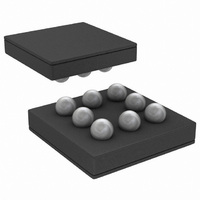LM3500TL-21/NOPB National Semiconductor, LM3500TL-21/NOPB Datasheet - Page 14

LM3500TL-21/NOPB
Manufacturer Part Number
LM3500TL-21/NOPB
Description
IC LED DRVR WHT BCKLT 8-MICROSMD
Manufacturer
National Semiconductor
Type
Backlight, White LEDr
Datasheet
1.LM3500TL-21NOPB.pdf
(20 pages)
Specifications of LM3500TL-21/NOPB
Topology
PWM, Step-Up (Boost)
Number Of Outputs
1
Internal Driver
Yes
Type - Primary
Backlight
Type - Secondary
White LED
Frequency
850kHz ~ 1.15MHz
Voltage - Supply
2.7 V ~ 7 V
Voltage - Output
19.5 V ~ 20.5 V
Mounting Type
Surface Mount
Package / Case
8-MicroSMD
Operating Temperature
-40°C ~ 85°C
Current - Output / Channel
640mA
Internal Switch(s)
Yes
Efficiency
85%
Lead Free Status / RoHS Status
Lead free / RoHS Compliant
Other names
LM3500TL-21
LM3500TL-21TR
LM3500TL-21TR
www.national.com
C
L = 22 µH, 160 mΩ DCR max. Coilcraft DT1608C-223
2 and 3 LED applications: LM3500-16 or LM3500-21; LED V
20mA; T
4 LED applications: LM3500-16 or LM3500-21; LED V
T
5 LED applications: LM3500-21 only; LED V
The typical cycle-by-cycle peak inductor current can be cal-
culated from the following equation:
where I
quency, L is the inductance and η is the converter efficiency
of the total driven load. A good typical number to use for η is
0.8. The value of η can vary with load and duty cycle. The
average inductor current, which is also the average V
current, is given by the following equation:
The maximum output current capability of the LM3500 can be
estimated with the following equation:
where I
include but are not limited to:
A
IN
V
2.7
3.3
4.2
(V)
= 25°C
IN
= C
OUT
A
OUT
CL
= 25°C
# LEDs
series)
= 1 µF
is the current limit. Some recommended inductors
Typical Peak Inductor Currents (mA)
(in
2
3
4
5
2
3
4
5
2
3
4
5
is the total load current, F
118
142
191
110
132
183
102
122
179
mA
15
82
76
64
mA
100
138
174
232
126
158
216
116
146
206
20
90
76
LED Current
mA
134
190
244
319
116
168
212
288
148
186
263
30
96
F
= 3.28V at 20mA; T
SW
is the switching fre-
160
244
322
413
136
210
270
365
116
180
232
324
mA
40
F
= 3.41V at 20mA;
mA
204
294
172
250
320
446
142
210
272
388
50
F
X
X
= 3.77V at
A
SW
= 25°C
mA
234
352
198
290
162
246
318
456
60
X
X
X
X
pin
14
Coilcraft DT1608C series
Coilcraft DO1608C series
TDK VLP4612 series
TDK VLP5610 series
TDK VLF4012A series
CAPACITOR SELECTION
Choose low ESR ceramic capacitors for the output to mini-
mize output voltage ripple. Multilayer X7R or X5R type ce-
ramic capacitors are the best choice. For most applications,
a 1µF ceramic output capacitor is sufficient.
Local bypassing for the input is needed on the LM3500. Mul-
tilayer X7R or X5R ceramic capacitors with low ESR are a
good choice for this as well. A 1µF ceramic capacitor is suf-
ficient for most applications. However, for some applications
at least a 4.7µF ceramic capacitor may be required for proper
startup of the LM3500. Using capacitors with low ESR de-
creases input voltage ripple. For additional bypassing, a
100nF ceramic capacitor can be used to shunt high frequency
ripple on the input. Some recommended capacitors include
but are not limited to:
TDK C2012X7R1C105K
Taiyo-Yuden EMK212BJ105 G
LAYOUT CONSIDERATIONS
The input bypass capacitor C
be placed close to the device and connect between the V
and GND pins. This will reduce copper trace resistance which
effects the input voltage ripple of the IC. For additional input
voltage filtering, a 100nF bypass capacitor can be placed in
parallel with C
The output capacitor, C
the LM3500 and connected directly between the V
GND pins. Any copper trace connections for the C
itor can increase the series resistance, which directly effects
output voltage ripple and efficiency. The current setting re-
sistor, R
copper trace connections that can inject noise into the sys-
tem. The ground connection for the current setting resistor
should connect directly to the GND pin. The AGND pin should
connect directly to the GND pin. Not connecting the AGND
pin directly, as close to the chip as possible, may affect the
performance of the LM3500 and limit its current driving capa-
bility. Trace connections made to the inductor should be
minimized to reduce power dissipation, EMI radiation and in-
crease overall efficiency. It is good practice to keep the V
routing away from sensitive pins such as the FB pin. Failure
to do so may inject noise into the FB pin and affect the regu-
lation of the device. See Figure 2 and Figure 3 for an example
of a good layout as used for the LM3500 evaluation board.
LED
, should be kept close to the FB pin to minimize
IN
to shunt any high frequency noise to ground.
OUT
, should also be placed close to
IN
, as shown in Figure 1, must
OUT
OUT
capac-
and
SW
IN













